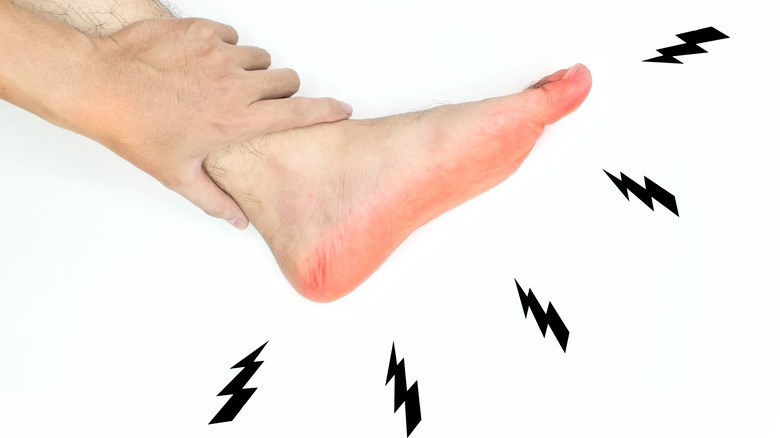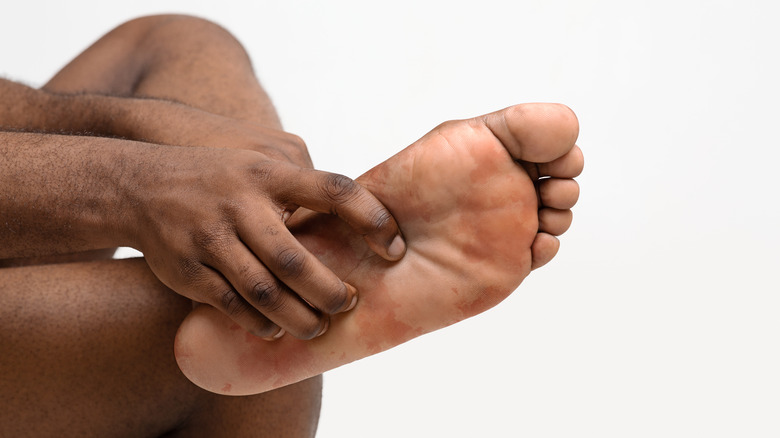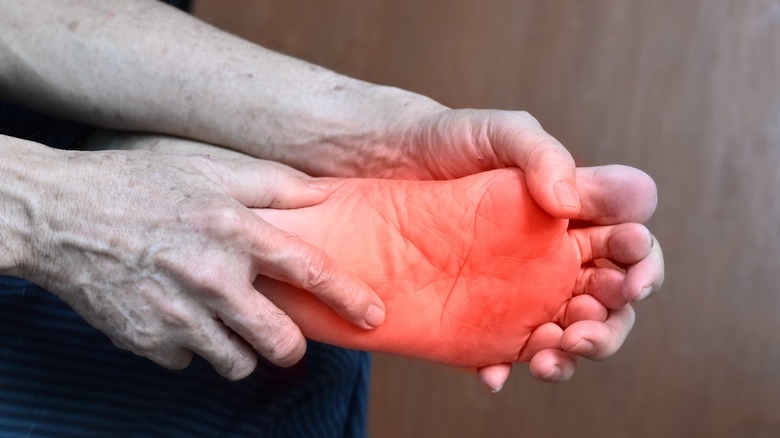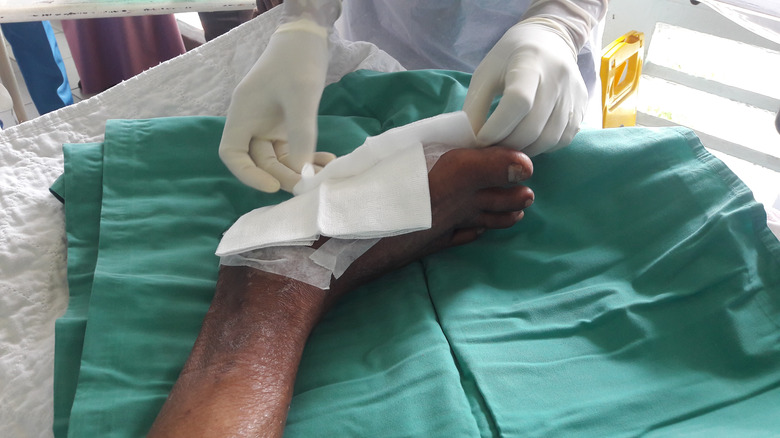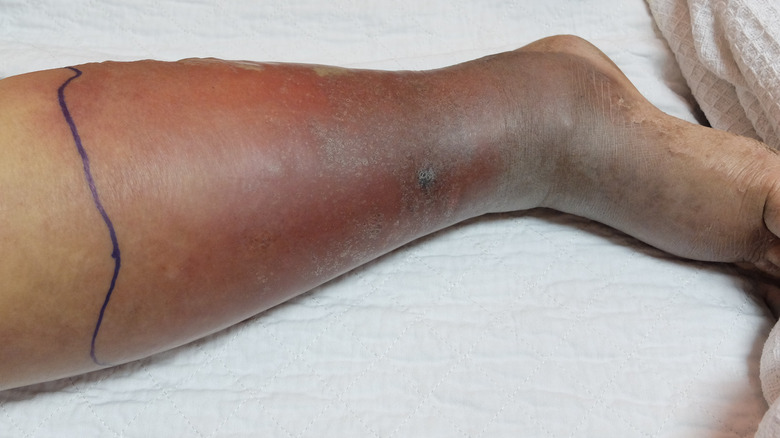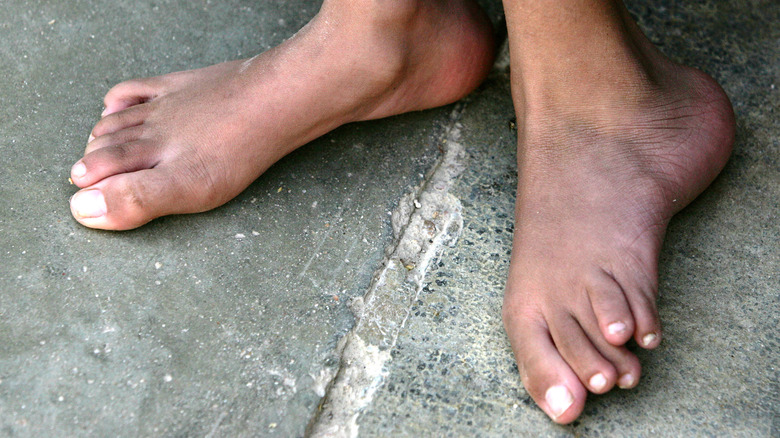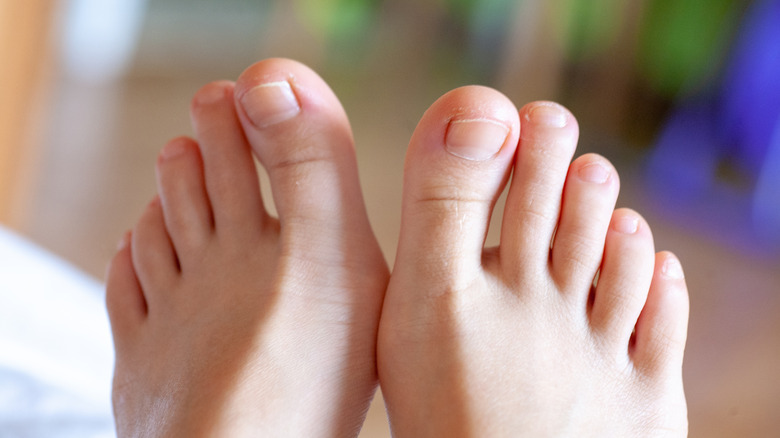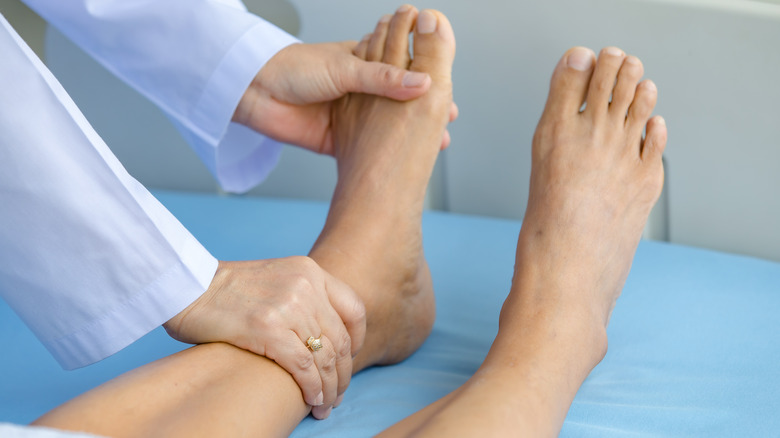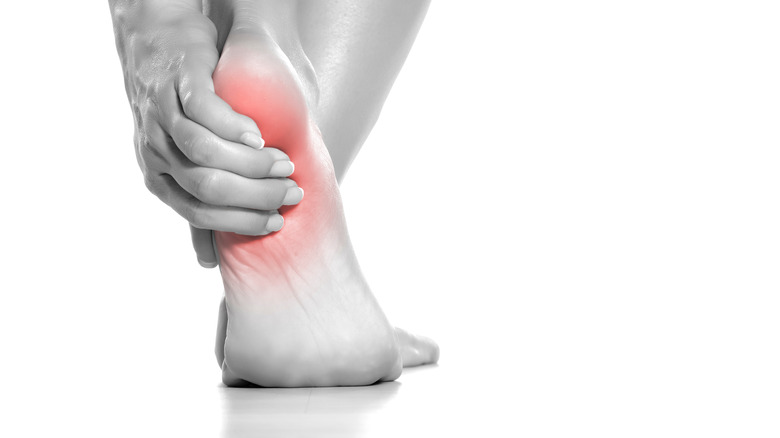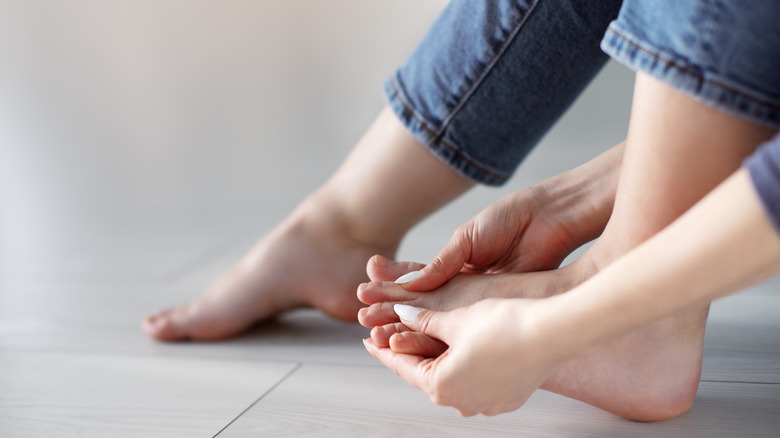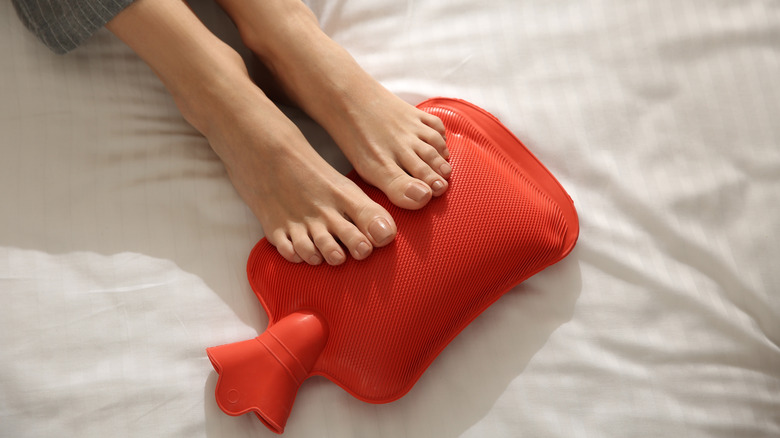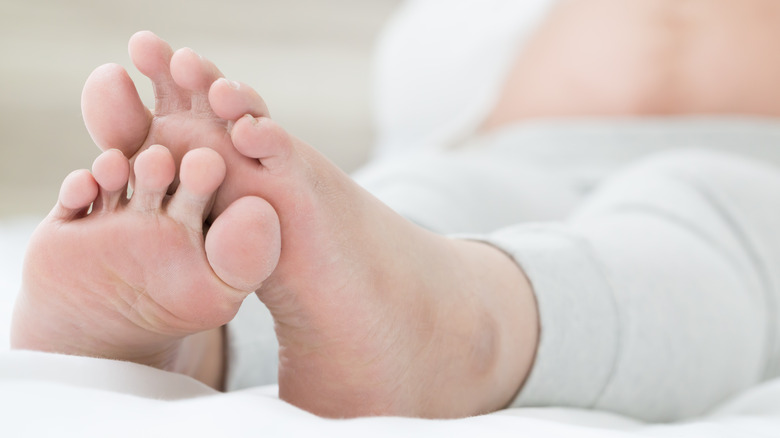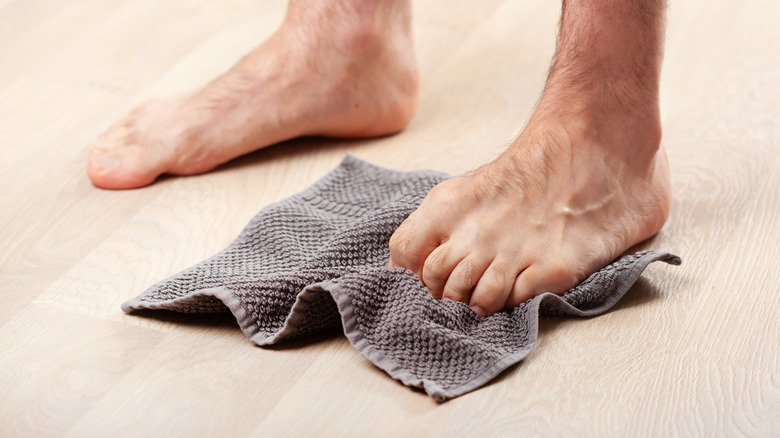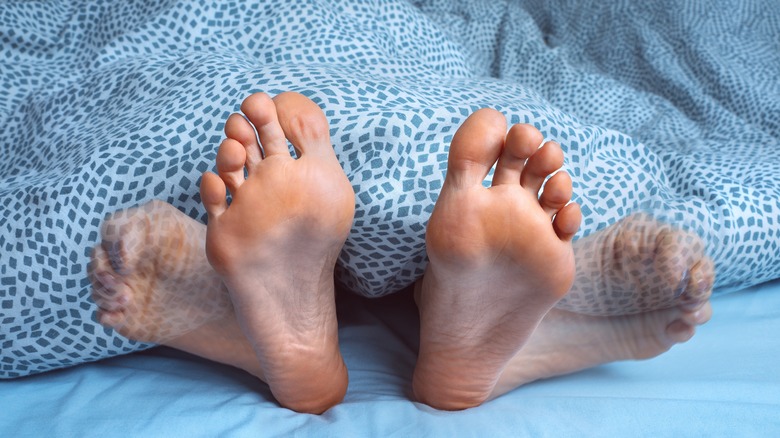Warning Signs From Your Feet You Shouldn't Ignore
The average person takes anywhere from 7,000 to 13,000 steps daily (via NBC News). Each time you place one foot in front of the other, you place at least the amount of your body weight onto 26 small bones, 30 joints, and over 100 tendons, muscles, and ligaments (via Dr. Scholl's).
Taking all of those steps causes the arch of your foot to settle, making your feet seem wider and longer. In addition, the padding on the bottom of your feet gets thinner, and your ankles feel stiffer as you age (via American Orthopaedic Foot & Ankle Society).
To help keep your feet healthy, be sure your toenails are trimmed straight across and not too short. It's also important to wear shoes that fit right and are comfortable (via Medline Plus). Finally, wash and check your feet daily. See your medical provider if you notice any skin problems, wounds, or other abnormalities — or any of the below warning signs.
Itching
Occasional itchiness is normal. However, if it gets to the point that you want to scratch the skin off of your feet, it's time to see a doctor. Also referred to as pruritus, the annoying sensation happens to your feet for several reasons, including skin issues and disease (via Healthline). Itchy feet result from exposure to moisture and irritants, bacteria, fungi, and viruses. Some of the more common issues that cause itchy feet include eczema, psoriasis, dry skin, athlete's foot, and insect bites. There are over-the-counter medications that treat and prevent itchy skin problems. However, if the itch persists, your doctor can prescribe creams, lotions, and pills to mitigate the symptoms.
However, sometimes the itch is more than skin deep. This is especially true if you have diabetes. If your blood sugar levels exceed the norm, itching is one of the first warning signs your body gives you (via Medical News Today). Diabetes often results in poor circulation, which also leads to itching and an increased likeliness of developing infections. Additionally, those with diabetes are also at an elevated risk of developing neuropathy, or damaged nerves, which can cause itchy feet.
To determine the cause of your itchy feet, your doctor may take a skin sample and send it for testing, including culture and biopsy. Blood tests help rule out other medical issues (via Healthline).
Burning
That feeling like you've strolled across hot coals? Doctors refer to it as burning feet syndrome, or Grierson-Gopalan syndrome (via Cleveland Clinic). There are many causes, and most require medical attention. One common cause is athlete's foot. Up to 15% of the population will contract athlete's foot (National Center for Biotechnology Information), a condition caused by a fungus that grows in humid areas, including damp shoes and socks (via Cleveland Clinic).
Neuropathy, or damage or dysfunction to one or more nerves, affects at least a quarter of the population, and can cause sensations of burning in the affected area (via Cleveland Clinic). Neuropathy has many causes, including disease and injury. Two of the more common conditions that cause neuropathy include hypothyroidism and diabetes. In addition, a low functioning thyroid and unregulated blood sugar cause burning feet, as can chemotherapy, rheumatoid arthritis, infections, and alcoholism can also cause peripheral neuropathy (via Cleveland Clinic). Another type of neuropathy associated with both burning feet and diabetes is small fiber neuropathy. Nearly half of those diagnosed with small fiber neuropathy had a heart attack (via Johns Hopkins Medicine).
Other medical conditions that cause burning feet include tarsal tunnel syndrome, Morton's neuroma, and Charcot-Marie-Tooth disorder (via Cleveland Clinic). If your feet are burning but you're not a fire walker, it's best to see a medical professional to determine the cause of your pain.
Ulcers that don't heal
An ulcer is a sore that either doesn't get better or keeps coming back. Though anyone can develop an ulcer, they are more prevalent in those with diabetes. Approximately 15% of diabetics will get an ulcer, and around the same amount will require amputation to treat the sores (via Cleveland Clinic).
Diabetic neurotrophic ulcers result from nerve issues and trauma to the legs and feet. Surrounded by callouses, these ulcers bleed and often appear on your heels (via Mount Sinai). Those with diabetes can also develop arterial ulcers, which are prevalent in smokers and those with high blood pressure or poor circulation as well. Arterial ulcers don't bleed and usually stop hurting when you swing your feet over the side of a chair or bed. Arterial ulcers usually appear in and around your toes, heels, and legs.
Ulcers start pea-sized and can grow to encompass the entire foot if left untreated. Doctors categorize ulcers based on their depth using the Wagner Diabetic Foot Ulcer Grade Classification System, which defines intact skin as grade 0 and a foot entirely enveloped in gangrene as grade 5 (via Cleveland Clinic).
Discoloration
Stub your toe on a midnight trip to the bathroom, and you will surely find a bruise in the morning. Besides injuries, many other underlying health conditions can cause your feet and toes to change colors (via Medical News Today). If cold or stress causes your feet to turn purplish, you could have Raynaud's disease. The color change is due to shrinking blood vessels and less blood flowing through your extremities. Once they return to normal size, the color should return (via Medical News Today). Red, scaly feet could be an indication that you have vasculitis (via American College of Rheumatology). Most associated with lupus, vasculitis causes poor blood flow and results from your immune system attacking your blood vessels. Infections, including cellulitis, where bacteria or fungus break through the skin due to an injury or wound and cause inflammation, as well as the Covid-19 virus, can both cause skin discoloration as well.
Deformities
Foot deformities are often caused by genetics and poorly fitting shoes (via Foot Deformities). However, other medical conditions, including different types of arthritis and obesity, can also contribute to deformities in the feet.
Wearing shoes that don't fit properly can lead to deformities such as heel spurs, corns, bunions, and hammertoes (via Johns Hopkins Medicine). Fallen and high arches, as well as pronated feet, also result from tight-fitting shoes. Rheumatoid and psoriatic arthritis cause your body to attack your joints and, if left untreated, could lead to deformity (via Buoyhealth). Likewise, osteoarthritis, or the wearing down of the cartilage around your joints, results from untreated foot deformities (via Foot Deformities).
Regardless of the cause or type of deformity, the skin on your feet could become calloused and painful without proper treatment. In addition, the extra pressure on your tendons and muscles could cause strains and tears. In addition to foot pain, you may also develop discomfort in other parts of your body, including your knees, back, and hips.
Balding toes
Everyone is born with around five million hair follicles distributed throughout your body, including on your toes (via Allure). People have two types of hair that grow on the body: vellus and terminal. Terminal hairs are found on your head, face, chest, and pubic area. The peach fuzz vellus hairs are found everywhere else, including your toes (via What Happens When You Age?).
If you suddenly notice that the hair on your toes is gone, you should see a medical professional about bald toe syndrome. While no hair on your toes may seem like nothing, it could indicate a dangerous health issue known as peripheral vascular disease, or PAD (via PodiaPaedia). PAD results from plaque that gathers in your arteries and diminishes your blood circulation. One of the side effects of poor circulation is that nutrients don't reach your feet at the rate they should. A lack of vitamins and minerals causes hair follicles to die. As a result, the hair falls off your toes, and they go bald (via Triad Foot & Ankle Center). Your risk of developing PAD increases as you get older, especially over the age of 60. Smoking, diabetes, and elevated cholesterol and blood pressure levels also make you more prone to PAD. PAD can lead to both coronary artery disease and cerebrovascular disease. Both can cause you to experience a heart attack or stroke (via the Centers for Disease Control and Prevention).
Tingling
Occasionally feeling a tingling sensation in your feet is normal and generally not something to agonize over. Also called paresthesia, feeling like your foot fell asleep is commonly due to placing too much pressure on the nerves that go from your heart to your feet. The feeling usually goes away when the compression is removed (via Harvard Health Publishing). However, extended periods of feet tingling affect over 20 million people, and be caused by one of a multitude of factors. Several chronic conditions cause foot tingling if left untreated, including diabetes and hypothyroidism (via Healthline). Multiple sclerosis and pregnancy can also cause foot tingling.
These health conditions and some injuries, particularly to the back, often cause neuropathy or nerve disease. The most common form is peripheral neuropathy, which often affects the nerves in your legs and arms and causes that tingly feeling (via Mayo Clinic). For the most part, peripheral neuropathy itself isn't treated. Instead, doctors treat the underlying cause. They may advise you stop smoking, get your blood sugar under control, and decrease your alcohol consumption. Prescription pain killers work better than over-the-counter medications for discomfort. Without treatment, infected foot ulcers, gangrene, and possible amputation can occur (via National Health Service).
Heel pain
Over two million people endure pain behind, beneath, and within their heels annually (via Cleveland Clinic). Heel pain is most often caused by wearing improperly fitting shoes. Shoes that don't fit right cause you to put unnecessary stress on your feet (via OrthoInfo). Other causes of heel pain include obesity, standing for extended periods, arthritis, arch issues, bruised bones, Achilles tendinitis, bursitis, and sports that include extensive running and jumping (via Cleveland Clinic).
Aside from these, one of the other most common causes of heel pain is plantar fasciitis. When you have plantar fasciitis, your heel hurts when you first start walking after long periods of sitting or laying down. Pain worsens first thing in the morning and improves with stretching, ice, and orthotic inserts (via American Academy of Family Physicians). Chronic plantar fasciitis often leads to heel spurs and calcium deposits on your heel bones, and these are treated similarly to the plantar fasciitis itself (via OrthoInfo).
Generally, heel pain is best treated with rest, ice, and over-the-counter pain medications. If that doesn't help, try getting new shoes or orthotic inserts to relieve the pain (via Mayo Clinic). If that doesn't alleviate the discomfort, a doctor can further diagnose what is causing your issue with a physical exam and x-rays.
Toe pain
Your toes are a complex make-up of bones, joints, muscles, tendons, ligaments, nerves, and blood vessels, all of which can be injured and infected, causing you pain. This pain is often accompanied by inflammation, irritation, and heat (via Healthgrades).
By age 50, one in forty people will have hallux metatarsal phalangeal (MTP), or arthritis of the big toe, which is one of the most common causes of toe pain (via FootCareMD). MTP flares when you place pressure on your toes while walking. The joint often swells when you try to bend it. The joint in the big toe also tends to be the one most affected by gout (via Foot Health Facts). Gout occurs when the kidneys don't break down enough uric acid, which builds up in the blood. Uric acid settles in the coolest part of the body that is farthest from your heart, the big toe. Changes in your diet are the best way to avoid flare-ups.
Other causes of toe pain include hammertoe, tendonitis, and turf toe. Hammertoe occurs when your toes get stuck in the bent position (via Foot Health Facts). Tendonitis is the inflammation of the tissue that connects your muscles to your bones (via Cleveland Clinic). Finally, turf toe is a sprain to the big toe (via OrthoInfo).
Cold feet
When the air temperature drops, it's not uncommon for your feet to feel cooler than the rest of your body. If warm socks don't do the trick, it could be poor circulation or another medical condition, and it's best to see a doctor for a proper diagnosis (via Cleveland Clinic).
One common cause of cold feet is reduced circulation. That means your blood isn't getting to your feet at the same rate it is reaching the rest of your body. Poor circulation results from not getting enough exercise, high cholesterol, and some heart conditions (via Medical News Today). Another reason you may have cold feet is anemia, or not enough red blood cells. A change in diet usually clears up this condition (via Healthline). Those with hypothyroidism or who have high blood sugar from uncontrolled or poorly controlled diabetes are also more prone to cold feet (via Medical News Today).
Swelling
Though generally painless, swelling in your feet is caused by a build-up of fluid called edema (via Mount Sinai). One cause of swollen feet is being sedentary — you stand or sit in one place for an extended period. Those who are overweight or older are also more prone to food swelling. Finally, hormone fluctuations, especially during pregnancy, cause swelling. However, women whose feet swell during pregnancy should have their provider check for preeclampsia, a dangerous condition for both mother and child. Other causes of swelling that require medical intervention include deep vein thrombosis (DVT) and heart, kidney, or liver failure.
If you notice your feet are swollen, lay down with your feet up. Call your doctor if your condition fails to improve after a few days, or if only one foot is affected. It's also a good idea to call your medical provider if your feet are also painful and discolored (via Harvard Health Publishing).
Discolored or bruised toenails
Medical professionals diagnose onychomycosis, a fungal infection, in half of all toenail infections. Though generally harmless, Americans spend millions each year on over-the-counter medications to try and rid themselves of thick, yellow, brown, or white toenails (via CDC). However, even with prescriptions, ridding yourself of the infection takes patience, and it's common for these infections to return (via Medical News Today).
Injuries — stubbing your toes, dropping something on your feet, and shoes that are too tight — can also cause trauma to your toenails. When this happens, it is often accompanied by a purple bruise that changes color over time to brown or black. Unfortunately, there isn't much you can do for bruising, and due to the slow pace at which nails grow, it takes months for them to heal (via Insider).
Those with diabetes are more prone to both fungal infections and toenail trauma, due to slower circulation — so if you notice repeated problems with your toenails, it's a sign you should speak to your doctor (via Medical News Today). You should also seek medical attention if you notice a line going down the center of your toenail, as it may be a dangerous form of skin cancer known as melanoma (via Insider). Other causes for concern include yellow nails, which indicate lymphedema or swollen lymph nodes, and red nails, which indicate malnutrition.
Restlessness
Up to 10% of adults in the U.S. have an uncontrollable compulsion to move their legs and feet, most often while sitting or lying down. These symptoms of restless leg syndrome (RLS) often increase as you get older (via MedlinePlus). The severity of symptoms varies from person to person (via NHS). Causes of RLS include an imbalance of dopamine in the brain, heredity, and hormonal changes due to pregnancy (via Mayo Clinic). RLS can also result from nerve damage caused by peripheral neuropathy, anemia and iron deficiency, kidney failure, and spinal cord injuries. Restlessness in your legs, feet, or toes often is worse at night when you should be sleeping (via MedlinePlus). Because these disorders disrupt your sleep, you may be drowsy during the day to the point where you have trouble functioning. Depression is another side effect (via Mayo Clinic).
Two similar disorders, painful legs and moving toes (PLMT) syndrome and painless legs-moving toes, are infrequently diagnosed (via National Organization for Rare Disorder). Those with these diagnoses have toes that curl together on one or both feet. Injuries to the peripheral nerves are most often to blame.
According to the Mayo Clinic, treatment includes various types of medications, including those that increase dopamine in the brain (such as Neupro) and those that affect calcium channels (such as Neurontin). If neither of these drugs helps, doctors prescribe muscle relaxers to help you sleep.
Not feeling pain
No one likes feeling pain. However, the hurt you experience is your body's way of telling you something is wrong. Pain indicates that an activity needs to be stopped and that a part of the body needs extra attention (via Nemours KidsHealth). For this reason, if you don't feel pain when you otherwise should, it's worth consulting your doctor to rule out a serious underlying condition.
A lack of sensation could be from the way you sit in a chair, or it could signify a chronic condition (via Medical News Today). Injuries may also cause numbness if they are compressing nerves in the area. If you don't believe that an injury prevents you from feeling your feet, it could be circulatory issues and lack of blood flow from peripheral artery disease (PAD) or deep vein thrombosis (DVT), according to HealthGrades. Neurological problems including multiple sclerosis, peripheral neuropathy, stroke, and lupus also hinder feeling pain, as does hypothyroidism.
Seek immediate medical attention if the numbness accompanies confusion, dizziness, difficulty breathing, changes in vision, or slurred speech. Make an appointment to see your doctor if symptoms persist or the appearance of your feet or legs changes.

